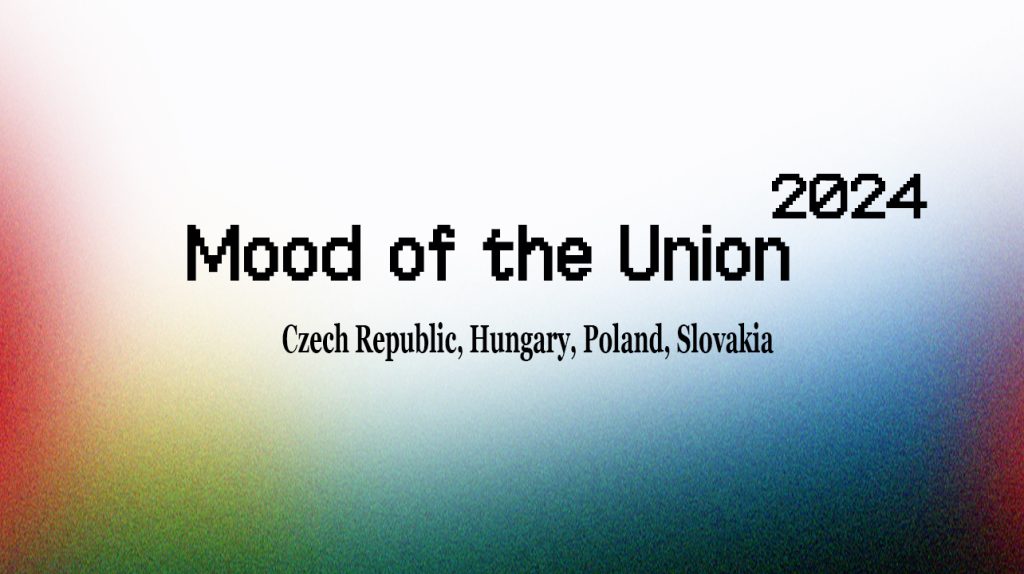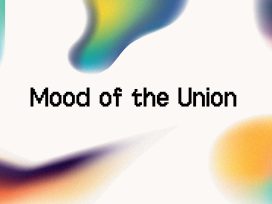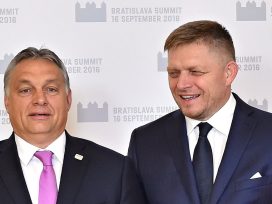Since the war in Ukraine, the Visegrád Four group no longer articulates a common voice in the EU. Even the illiberal alliance between Hungary and Poland has come to an end. Yet in various ways, the region still demonstrates to Europe the consequences of the loss of the political centre.
An ungenerous observer might say that the Visegrád group – made up of the Czech Republic, Hungary, Poland and Slovakia – has become notorious for illiberalism, xenophobia and obstructionism without showing real unity, let alone articulating a positive political platform.
Despite a sudden change in roles, this perspective has only been reinforced in recent months. After the electoral defeat of Poland’s governing Law and Justice party last autumn, the EU’s intra-Visegrád ‘marriage of inconvenience’ between Hungary and Poland looked to have finally broken up. But at that very moment, Slovakia’s new-old government under Robert Fico – who was nearly fatally attacked on 15 May – started to send signals that Slovakia might replace Orbán’s former Polish partner to form a new ‘coalition of the unwilling’.
In fact, not even this odd form of continuity can hide the deeper reality: that since Russia’s escalation of its brutal war of aggression against Ukraine in early 2022, the Visegrád Group (V4) – established in 1991 to advance co-operation in military, economic, cultural and energy affairs between what were only three countries until 1993 – can no longer be considered a meaningful political unit.
The ongoing attack on a country with which Poland, Slovakia and Hungary all share an eastern border has led to a widespread realisation of just how crucial the future shape of this part of the EU could prove. However, the more vocal among them – Poland and Hungary – have positioned themselves at opposite ends of the European spectrum when it comes to the first major war of aggression launched by a great power (and a UN Security Council member) on European soil since WWII.
Nonetheless, recent developments in these countries, divergent as they are, have essential lessons to offer for the European Union as a whole. If the crucial question of the upcoming European elections is whether the political centre – consisting primarily of status quo conservative and liberal forces – will maintain its hold on power, or whether illiberal and far-right candidates will achieve a breakthrough, then Poland and Hungary provide striking examples of what the consequences of the latter scenario might be.
Shifts and a shock
Despite structural similarities, the four Visegrád countries have always tended to take divergent paths, or at least develop in an asynchronous manner. This is clearly the case today too.
Hungary has a rightwing, increasingly authoritarian regime that has been built up methodically since 2010; the ruling party Fidesz has in many respects succeeded in rebuilding the country and its institutions in its own image. It commands strong networks of patronage and is embedded socially. As a result, Viktor Orbán’s party has been repeatedly re-elected in elections that qualify as ‘free but not fair’. The Hungarian opposition, sorely lacking in resources, young talent and new ideas, has performed poorly on an increasingly uneven playing field. Despite seeing a drop in popularity in recent months, Fidesz remains far ahead of its challengers in the most recent polls – also because its main new rival, Péter Magyar’s Tisza Party, has attracted most of its voters from the opposition.
Hegemonic and now monopolistic in several areas, Fidesz has radicalised further in recent years. In 2021, under threat of expulsion, it chose to walk out of the European People’s Party, with Orbán aspiring to become an influential rightist-illiberal politician internationally. Fidesz’s affiliation in the European Parliament has remained an open question ever since; the elections may help to clarify this.
Fears that the situation in Slovakia could soon seriously deteriorate have only been exacerbated since the shocking assassination attempt on Robert Fico. The political situation in the country had already become much more volatile and far less predictable than in Hungary. Smer–SD (Direction – Social Democracy) re-emerged as the leading party in the 2023 Slovak elections, winning for the fifth time in the sixth election since 2006 and returning the ‘technician of power’ Robert Fico to power for a fourth term. A nominally left-leaning, culturally conservative and Eurosceptic party with post-communist origins and populist inclinations, Smer has been suspended by the Party of European Socialists for a second time for joining a coalition with the far-right.
However, Smer–SD’s popularity peaked over a decade ago. The new three-party, ‘leftist-rightist’ coalition possesses only a slim parliamentary majority, though it is also closely allied with the recently elected president, Peter Pellegrini. The parliamentary opposition consists of six, predominantly liberal, Christian democratic, and conservative parties. The largest of them is a progressive liberal formation led by Michal Šimečka, who turns 40 this year and who has already built up an impressive career on the European stage, having served as vice president of the European Parliament and the liberal group Renew Europe. Šimečka’ liberals have the potential to lead a centrist, pro-European majority in the future.
However, things are likely to get worse before they get better in Slovak politics. The current coalition looks intent on weakening internal democratic controls, not least by diluting anti-corruption measures, restructuring the public media and attacking NGOs. The crucial questions right now are whether the assassination attempt will radicalize this process further, and if so how far the government will advance down the Orbán path.
Recent developments in Poland pose the reverse question: how much can the incoming, conservative-liberal-leftist coalition led by Donald Tusk – Polish prime minister for two previous terms between 2007 and 2014, then European Council president until 2019 – overcome the powerful illiberal trends of recent years and re-establish rule of law in the country? Poland is currently split into two roughly equally large political blocs, respectively named Civic Coalition and the United Right, a split likely to be closely reflected in the upcoming European elections too. The country has thus emerged as a key example of what is often called an anti-illiberal turn.
Just like back in 1989, when Poland was the first to exit its Soviet-style regime, there are no detailed maps at the country’s disposal, and the road ahead promises to be bumpy. Donald Tusk’s new government needs a sense of proportion when deciding what to undo and how – in other words: how to foster a robust and consensually supported liberal democratic system in what remains a deeply polarised country.
In this sense, Poland can be viewed as the single most important political battleground within the European Union today. Supporters of democracy in Europe will learn much by paying attention to the new government’s key policies, such as the recently introduced Action Plan for restoring the rule of law, which among other things establishes a new Constitutional Tribunal and rebuilds the system of constitutional review – policies that may prove salutary in general but are ambiguous in their details.
The Czech Republic has provided less drama but fewer hopes since prime minister Petr Fiala – a former university rector who represents the pro-market, conservative Civic Democratic Party – took office in late 2021 as head of a predominantly centrist coalition (which itself consists of two ‘party coalitions’ representing five parties in total). This complex coalition managed to unseat populist entrepreneur Andrej Babiš’s ANO 2011, despite remaining the most popular party (like Law and Justice in Poland). The divisive Babiš was subsequently defeated in the presidential race of 2023 with a surprisingly large margin, this time by the retired army general and former chairman of NATO’s Military Committee, Petr Pavel.
If the Czech electorate’s recent choices reaffirmed the country’s western geopolitical commitments, including clear support for both Ukraine and, more controversially, Israel, the Fiala government’s oft-praised international orientation contrast sharply with the poor performance and grave socioeconomic effects of its policies at home. This has led to record lows in the government’s approval ratings during the first half of its term and created a new opening for ANO 2011, which is again leading in the polls by a substantial margin. In the finest tradition of Czech irony, Babiš’s party belongs to Renew Europe, the liberal grouping in the European Parliament. Whether liberals in the EU will have reason to celebrate the mandates that this newest turn in the Czech saga is likely to add to the group is a different matter.
Slovakia and the Czech Republic thus form another strange couple, one that may be said to stand for growing disenchantment and new fears: the current Czech government has largely disappointed the hopes invested in the country’s path towards socioeconomic recovery after the pandemic, just as the political situation in Slovakia has also started to deteriorate. For the Visegrád Four, the overall picture is far from rosy.
Muddying the waters
These divergent political developments cannot easily be connected to social levels of support for the EU and European integration, whose constants are more striking than any new trend. According to recent Eurobarometer surveys, Poles remain significantly more pro-European than the ‘average European’, whereas Czechs are still disproportionately prone to Euroscepticism, with Slovaks falling somewhere in between – and close to the EU average. Largely because of regime propaganda, Hungary has exhibited a notable downward trend and is now among the bloc’s more Eurosceptic countries – though remains less so than the Czech Republic.
But with Fidesz unaffiliated, Smer–SD currently suspended, the Polish electorate split, and the Czech populist party belonging to the liberals, the electoral behaviour of voters in the Visegrád countries is unlikely to impact significantly on the balance of power between fractions in the EU parliament. While European Parliament elections may have become more than ‘second-order elections’ in recent years, citizens of the Visegrád Four could therefore be forgiven for still not attaching too great importance to them. The most they can likely achieve in June is to strengthen Eurosceptic voices at various points on the political spectrum.
The complexity of these ongoing political trends cannot hide an important fact about the Visegrád Four: PMs Fiala, Fico, Orbán and Tusk all belong to the same generation. They are men who began to make an impact back in the 1980s; even Fico, the youngest of them, as well as the only one to have been a member of the communist regime rather than the opposition, will hopefully soon enter the seventh decade of his life.
Some three and a half decades after the 1989 revolutions, and two decades since the EU’s ‘Big Bang enlargement’, the most powerful politicians in the region are still those first socialised before the first watershed. One could argue that this represents remarkable stability; but it is far from the best proof of the region’s democratic maturity – not to mention progress in terms of women’s political representation.
Half a voice
There is a wide discrepancy between how much influence central and eastern European countries, including the Visegrád Four, can exert on the EU as individual nation states and how much via transnational agency. While they are politically overrepresented as compared to their demographic ratio or economic weight, they remain underrepresented in transnational networks and European elites. This discrepancy makes the current union of 27 states less balanced than its predecessors.
It also contributes to central and eastern Europeans typically preferring the intergovernmental logic of integration as opposed to the supranational and potentially federalist one. In other words, they predominantly seek a Union that ‘rescues the nation state’. Add to that the veto powers of member states – which obstructionist representatives of the Hungarian state have been particularly eager to use and abuse – and the impression emerges of a dysfunctional EU in urgent need of reform.
Poland – the country that has benefitted the most from EU-style integration as a major net recipient of EU funds and that has achieved significant economic development more generally – constitutes a partial exception to this pattern. Poland has clearly increased its weight and role both on the European stage and within the V4. However, it has done so without overcoming the ‘Italian syndrome’ of the late nineteenth and early twentieth centuries. Poland today belongs in a different category from the ‘small states’ of central and eastern Europe, but in many ways it has remained the ‘least great of the great powers’.
In theory, the EU is based on what the Greek academic Kalypso Nicolaïdis has called ‘transnational non-domination’ – or a conscious form of size-blindness. The union has indeed implemented numerous original methods that attempt to realise such a laudable, if slightly utopian project – though, as patterns of obstructionism indicate, these can function only in a climate of mutual trust and sufficient cooperation. In practice, however, there has always been a clear and predictable hierarchy between member states. Despite formal parity, countries still cast different shadows. Understandably enough, Poland hopes to join the EU’s elite club of states and can indeed claim to have achieved a few notable successes in this regard (the Weimar Triangle, Tusk’s European Council presidency, Jerzy Buzek’s role as President of the European Parliament, etc.).
However, there have also been notable exceptions to the ‘Polish exception’. When it comes to the EU’s often all too conciliatory approach to Russia in previous years (exposed in Sylvie Kauffmann’s book Les Aveuglés / ‘The blindsided’), Polish political and diplomatic elites have often felt underestimated or even slighted. Western Europe’s dismissal of Poland’s reasonable opposition to Nord Stream as a form of ‘Russophobia’ offers a perfect illustration of this.
But there is another, less obvious dimension to these developments. Poland has tended to assume the role of a ‘regional spokesperson’, often through appointment ‘from above’, i.e. by European institutions or as privileged partners of ‘greater western powers’, rather than through agreements within the Visegrád Group. This is not only down to divergence and discord among the Visegrád countries; it also has to do with Warsaw’s limited expertise, or simply lack of deep interest, in its ‘southern neighbourhood’. When compared to the lucrative possibilities of the grand European stage, a narrow regional forum appears to today’s ‘least great of the great powers’ like having to play second fiddle.
Too little, too late
If the EU’s structural funds have boosted state resources across the Visegrád countries over the past two decades, these compensatory subsidies have achieved little in the way of eliminating the socioeconomic gap between the union’s core areas and its eastern peripheries. Driven by expanding markets and lacking a similarly ambitious social agenda, the EU’s enlargement in the early 21st century was always likely to reproduce if not deepen imbalances in core-periphery relations. The large-scale emigration of the young and the more educated – notwithstanding the numerous, tangible benefits this process has brought – has also reinforced the conservatism of peripheral societies.
The specific manner of the EU’s partial and increasingly contested ‘easternisation’ explains why the growing threat of de-democratisation has come to assume a primarily ‘central eastern European’ complexion. Despite similar trends in a host of EU member states outside eastern Europe, illiberal rule has in recent years been instituted in Hungary and Poland in more acute forms than anywhere else in the union. Unfortunately, this has also often been interpreted through crude stereotypes.
When we try to assess the EU’s response to such trends, it is worth recalling that membership in the European Community (the precursor to today’s European Union) only became explicitly linked to the consolidation of democratic rule in the context of the bloc’s enlargement to include the post-authoritarian states of southern Europe. As Kiran Klaus Patel argues, it was during the 1970s and 1980s that political elites in these countries started to connect democratisation with the notion of Europeanization. This was when the EC began to claim to possess competences in promoting and consolidating democracy in aspirant member states – claims that were bound to remain controversial considering the EU’s own ‘democratic deficit’.
In the decades since, the EU has made repeated assertions of being an effective supporter or even a guarantor of democracy. But there is at least one country – Hungary – whose membership blatantly contradicts such assertions. The question is therefore whether the EU lives up to the rhetorical promises it has made on democracy since the 1970s when faced with an illiberal regime-building project at an advanced stage in its very midst.
The union’s record until now has been far from encouraging, especially when it comes to devising new ways to revive democracy in struggling member states. Partly out of respect for the principle of mutual recognition, but also out of complacency, European institutions have reacted only belatedly to deepening de-democratisation in Hungary and Poland. Worse, there has been no coherent and sufficiently ambitious strategy. Analysts remain divided on whether the EU’s weak response has constrained illiberal projects or unwittingly enabled them.
The ‘sharpest’ tools that EU institutions have employed in recent years were lengthy and only partially effective article 7 procedures, and repeated financial threats, which were soon followed by bargain deals on ‘fundamental values’ (as was the case with Hungary’s Corona Recovery Funds). How exactly citizens were supposed to benefit from such a slow, convoluted not to say unprincipled approach, or to sincerely continue to believe the rhetoric about a ‘community of values’, is anybody’s guess.
Learning from the V4
The possibility of an illiberal and far-right breakthrough in the upcoming elections is more worrying because the centre-right has been in sharp decline in several member states – not only in Hungary, but also in EU countries like France or Italy.
The centrality in recent decades of a bloated European People’s Party in the European Parliament – a supposedly centre-right party group that expanded after the Cold War to include rightwing forces such as Silvio Berlusconi’s Forza Italia, Orbán’s Fidesz or the Croatian Democratic Union – has partially obscured Europe’s alarming shift to the right. But it should be clear by now that the centre-right’s loss of influence, and the concomitant rise of the illiberal and populist right, leaves liberal democratic norms and support for European integration increasingly uncertain.
It is above all the absence of notable liberal conservative forces in a right-leaning country that makes Hungarian democracy appear such a hopeless cause. And more than any other factor, it is the continuing power of liberal conservatism in similarly right-leaning Poland that offers that country a new chance at a liberal democratic future. This political lesson may soon prove crucial for the European Union as a whole.
Published 23 May 2024
Original in English
First published by Eurozine
© Ferenc Laczó / Eurozine
PDF/PRINTPublished in
In collaboration with
In focal points
Newsletter
Subscribe to know what’s worth thinking about.
Related Articles

Nine years ago, a slim majority of UK voters chose to leave the European Union – without a clear plan or the tools to make it happen. Five years after the de facto departure, relations are slowly being repaired, driven in part by the increasingly unpredictable political climate in the United States.

Four months into Trump’s second term and the president’s ICE raids on immigrants, triggering protests in Los Angeles now under troop surveillance, prove that ‘democracy is under assault’. Could a historic courtroom reprimand provide the necessary guidance for a moral reset?







